Cult of the Child-God Crosses a Millennial Milestone
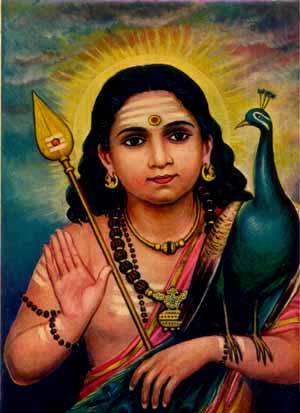
|
| Śrī Gnana Pandita, Murugan the Gnana Pandita or Expositor of Gnosis with His symbols the Vel Ayudha or Spear of Wisdom and vehicle/totem the Peacock = Phoenix. Behind Him rises the morning Sun symbolising bodhi (the awakened mind). |
by Patrick Harrigan
In truth, the composite deity Skanda-Murukan is two gods combined in one or, rather, two deities yet one indivisible God. As such, he is a perplexing god of paradox and apparent contradictions. In Skanda or Murukan we see a metaphor for India's magnificent diversity within national unity, a marriage of Dravidian and Aryan linguistic and cultural traditions. Indeed, this god is a fitting symbol of India's multi-ethnic, multi-linguistic heritage. As an amalgam of peoples sharing a proud heritage, India, like Murukan Himself, enters the new millennium filled with ever-youthful confidence, vigor, intellectual vitality and unflagging hope.
This same Skanda Kumara or Karttikeya has long been known to Sanskrit scholars as the Vedic personage mentioned in the Chandogya Upanisad by the name Sanat Kumara. The Taittiriya Aranyaka mentions both Sanmukha and Mahasena. There cannot be any doubt that at the time of the composition of the Baudhayana Dharma Sastra, many of Skanda's popular names were well known. The testimony of this work shows that the worship of Skanda was practiced well before 400 B.C. 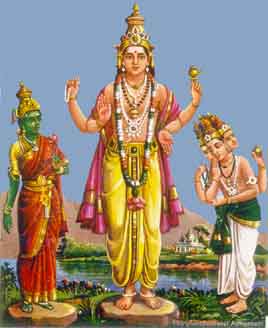
At the same time that Karttikeya's popularity was on the rise in North India, far to the South Murukan or Ceyon the Red God had already long been established as the Tamil Katavul, the patron and symbol of Tamil language and culture. For Tamils, however, Murukan was regarded not as a celestial divinity but as the personification of courage, the antidote to distress in the form of ananku and the victor over Cur or Terror personified. His triumph over terror and fear is immortalized in his Surasamharam, symbolizing the ultimate victory of courage over fear and love over hatred. For Murukan does not destroy his foes but transforms them and raises them to become forces working on behalf of all humanity. This age-old lesson continues to be celebrated to this day wherever Tamils worship Murukan.
By the time the epics Mahabharata and Ramayana were compiled, Skanda or Murukan had become a favorite god of Indians both North and South. This is proved by the repeated references to his exploits in various places in the Epics. Indeed, except for Visnu and Siva, more verses have been devoted to Skanda Kumara in the Mahabharata than to any other god. It appears from the Mahabharata XII.153.76 that Karttikeya was regarded as one of the four principal gods, namely Rudra, Kumara, Brahma and Visnu. 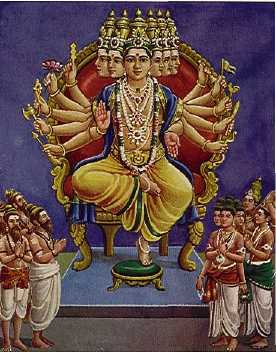
The Ramayana has two chapters on Karttikeya's birth in the Balakanda (chapters 36-37). The stories of Salya, Anusasana (86th chapter in Mahabharata) and Balakanda consistently make Karttikeya the son of all five deities: Siva, Agni, Ganga, Uma and the Krttikas. It appears that the authors of these accounts were not sure about the parentage of Skanda and, therefore, thought it prudent to give the honour of parenthood to all five deities. In the later period the question of Skanda's parentage became almost an enigma, as shown by a sloka from the Adiparvan of the Mahabharata (cited in Asim Kumar Chatterjee, The Cult of Skanda-Karttikeya in Ancient India, p. 13-14):
Agneyah Krttikaputro Raudro Gangeya ityapi
sruyate bhagavan devah sarvahuhyamayo Guhah
"Some call him the offspring of Agni, some of the Krttikas, some of Rudra and some of Ganga. The illustrious Guha who combines in his composition the portions of other deities is of a lineage unknown."
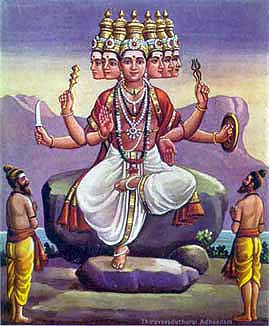
In both the epics and the Puranas, Karttikeya is repeatedly compared with the Sun god. In the Vanaparvan (chapt 224) we are told that the child Karttikeya 'shines like the sun rising in the midst of red clouds'. This association of god Skanda with the sun, the dawn, and red clouds has obvious affinities to the ancient Dravidian god Ceyon, the Red God who is none other than Murukan. Indeed, the imagery of Skanda and Murukan continue to play a role in the popular imagination of Tamil people right down to the present day.
Ancient Indians of both North and South noticed the similarities from the very beginning and readily identified Skanda with Murukan. Over the centuries, pandits and devotees have spoken with one voice in agreeing that these two are one and the same god. Nevertheless, there are real difference between North and South, Skanda and Murukan, Tevayanai and Valli Amma. These differences are inescapable and undeniable. And yet, they do not detract from the god's undying popularity and mystery. Rather, they add dimensions of complexity that are often lacking in simpler deities. Murukan is a god of romantic love. He is the husband of not one wife but two. And yet, in the Northern recension Karttikeya is an austere bachelor god. 
In certain respects, both ancient and modern traditions about this god point to similar conclusions. Wherever one looks, Kumara is a brilliant undying youth. His character reveals an underlying streak of playfulness that often borders upon mischief. It may be said that Skanda is a prankster among deities, rivaled only perhaps by his 'older brother' Ganapati.
This playful quality, combined with His propensity for assuming disguises and his inscrutable ways, has earned for Guha 'the Mysterious' both the respect of his devotees and their bewilderment at His activities. Cemman Makalai Tirutum Tirutan, 'the Thief Who Stole the Red Deer's Daughter', was already considered as a scampish, roguish character as early as the composition of the Atharva Veda, where the section called the Skanda Yaga is also entitled Dhurta Kalpa or 'Rogue Ordinance'. This term dhurta in Sanskrit can only mean 'rogue'.
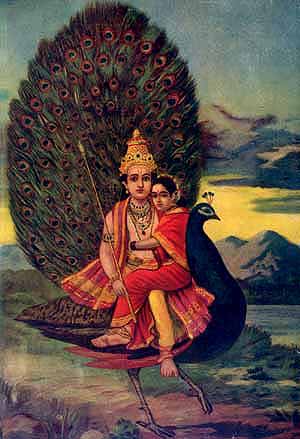
Even today, the god of Katirkamam in Sri Lanka is widely regarded as a rogue or rascal who knowingly colludes with thieves, poachers, the criminal underworld, politicians and all classes of people. This view is shared by Sri Lankan Buddhists, Hindus and Muslims alike. And yet, all agree that he is a beneficent god, a granter of boons and all good things, from health and wealth and happiness to the summum bonum of human existence, mukti or release from the bondage of ignorance.
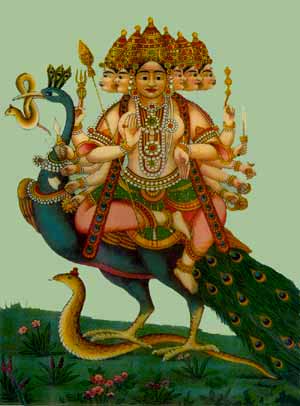
|
Shanmukha Subrahmanya |
As the wargod not only of Tamils but for people all over the Indian subcontinent including Sri Lanka, Skanda-Murukan commanded the respect and allegiance of entire kingdoms. Today we are witness to the fact that the god has, as it were, crossed the dark waters to become at home in nations like Sri Lanka, Malaysia, Singapore, Australia, Fiji, Mauritius, Reunion Island and South Africa, not to mention the western nations of Europe, Australia and North America.
Among His devotees today, one may also see many ethnic Chinese in Malaysia and Singapore. Black African Christians and others lift the kavati and dance in his honour in Mauritius and elsewhere. And not a few Western scholars who study him have become his admirers. Today Murukan has his own sites on the Internet in the digital realm as well. Who can say what the future may hold for a god whose ancient cult continues to display such vitality and ability to evolve, adapt and flourish amidst these turbulent times and ever-changing circumstances?
The First International Conference Seminar on Skanda-Murukan, unprecedented as it is in the history of modern scholarship, was long overdue. One happy outcome of the Conference was that delegates unanimously opted to establish a permanent organization to foster Kaumara studies worldwide for generations to come.
Skanda-Murukan articles index page
|


 Download this article as a PDF file (166 kb)
Download this article as a PDF file (166 kb) 





